
- - - -
INDUSTRIES - - -
- Shelby
Centre Mills / Center Mills / City Mills
-
- There
is a bit of a mystery about the early days of Shelby Centre/Center/City
Mills. The earliest known newspaper
- advertisement
for a Shelby mill appears in the Shelby Chronicle.
-
-
-

- Shelby
Chronicle - March 14, 1867.
-
-
- David
Lowrie,
born c. 1823 in Glasgow, Scotland was living in Shelby and listed
in the 1860 and 1870 Federal census as "Mill Wright"
and "Miller". In the early 1860s, he was the proprietor
of the Shelby Centre/ Center Mill which was located on the north
side of Main Street, just west of the Blackfork bridge. (This
mill location was known by the various names of Centre / Center/
and finally City Mills.)
-
- Not
much is known of David and his wife, Agnes Smith Lowrie, who
was born in Perth, Scotland.
- Agnes
and David were the parents of at least the 5 following children:
- David
Robert Lowrie born Oct. 1855
- John
Lowrie born c. 1858
- Peter
William Lowrie born c. 1860
- Isabella
Lowrie born c. 1863
- Adam
H. Lowrie born c. 1865
-
- The
1880 Federal Census shows they were located in Rochester Twp.,
Lorain County, Ohio and David as well as David Robert listed
their occupations as "miller". The elder David and
wife Agnes have not been located in the 1900 census and it is
assumed they had passed away by then. David Robert Lowrie, his
new wife Edna and their 4 children, are living in Cleveland,
Ohio in 1900. He is employed as a painter.
-
-
- The
mystery surrounding the Centre / Center Mill involves another
David Lowrie. This is David L. Lowrie born c. 1845 in
England. He first appears in the 1870 census living in Shelby
with the occupation of "hardware merchant". This fact
coupled with notices and advertisements that appeared in the
Shelby newspapers in the late 1860s indicate that this David
L. Lowrie was then the proprietor of the Centre Mill.
-
- David
L. Lowrie married Elizabeth Meyers who was born in Cleveland,
Ohio in 1846. He has not been located in a census prior to 1870,
however their first child Kattie E. was born c. 1868 in Ohio
as well as James born c. 1870 and Lula born c. 1876.
-
- There
has been found no evidence that these two David Lowries were
related, however it is interesting that they both were tied to
Cleveland, Ohio. By 1880, David L. Lowrie and family had moved
to the Cleveland area where he was a salesman of "mantles
and grates". He died there in 1886. The elder David Lowrie's
son, David Robert Lowrie, also moved to Cleveland where he died
in 1924.
-
-
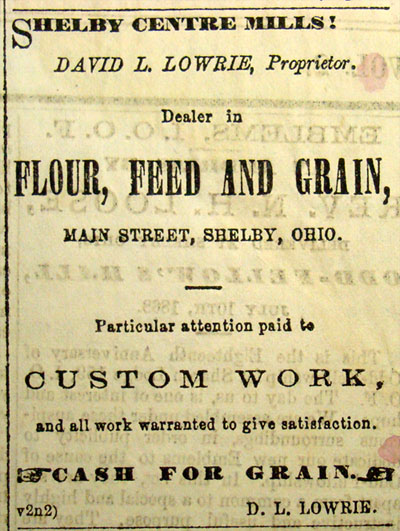
- Shelby
Chronicle - Feb. 1868
- (The
last ad for Shelby Centre Mills with David L. Lowrie proprietor
ran July 22, 1869.)
-
-
- Article
in the Shelby Independent News - October 14, 1869
-
- "D.
L. Lowrie, in his new business of selling hardware, keeps well
up to time in supplying the people with
- what
they need. He has just procured the Jewett & Root Cook and
Parlor Stoves, which we all would do
- well
to look at, who think of purchasing an article of that kind.
He also keeps on hand the Union Churn,
- manufactured
in Tiffin, Ohio. He advertises Oils and Paints at reduced prices,
and now is perhaps the
- very
best time in the whole year to use these articles on your buildings
that need repainting. He also keeps
- on
hand horse blankets, something every horseman should now have.
Also, all kinds of Carriage Trimming.
- Call
on him when anything is wanted, and he will show you a nice stock."
-
-
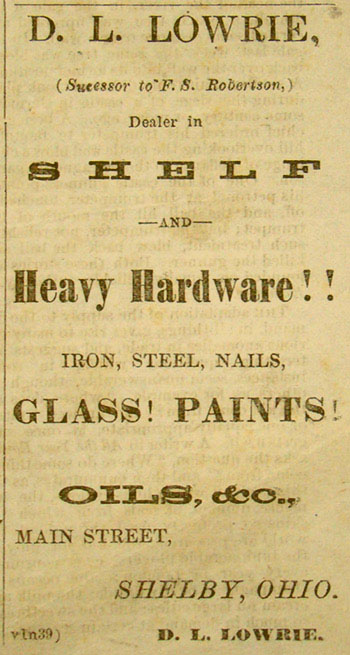
-

-
-
- Notice
in the Shelby Independent News - July 22, 1869 reads as follows:
-
- "Mr.
D. L. Lowrie has sold one half interest in the Shelby Center
Steam Flouring Mill to John Sprague Esq.
- for
five thousand dollars. The business will be hereafter conducted
by Messrs. Lowrie & Sprague."
-
- Notice
in the Shelby Independent News - July 29, 1869
- "John
Sprague , Esq., has purchased the remaining half of the Steam
Mill of D. L. Lowrie, and is now the sole owner
- of
the Shelby Center Mills. Mr. Haffstodt is engaged as his miller,
whose work we learn, has given entire satisfaction."
-
-
-
- It
was about this time that a new mill was going into business at
the north edge of Shelby where North Broadway
- crosses
the C. C, C. & I (Cleveland, Columbus , Cincinnati, and Indianapolis)
railroad tracks.
- It
was called the Junction Mill and David
L. Lowrie was a partner in this new enterprise.
-
-
-

- Shelby
Independent News - starting August 26, 1869
-
-
-
- As
can be seen in the advertisement reproduced above, by late 1869,
the Shelby Center Mills had been sold to
- John
Sprague who also was born c. 1823 and who continued the milling
business for a few more years. John
- Sprague
married Rebecca Evans in August of 1855. She was a daughter of
David and Mary Margaret Evans.
- Rebecca
was born c. 1827 in Sharon Twp. one of at least 6 children. John
and Rebecca were to raise 4 children:
- Isabella
"Belle" Elizabeth Sprague who in 1872 married Albert
O. Bell
- George
Stewart Sprague who married Alice Emily Crall (d/o David and
Maria Mary Stentz Crall) in 1882
- Jenny
R. Sprague born c 1864
- Nelli
M. Sprague born c. 1870
-
-
-
- Notice
in the Shelby Independent News - September 30, 1869:
-
- "John
Sprague's new addition to the Center Mills, intended for a feed
store, extending South to the sidewalk, is up.
- Also,
a new pair of Fairbanks Scales near by. The town is still improving."
-
-

-
-
- John
Sprague sold the mill to Samuel Haislet and by the 1880 census,
John was listed as a farmer living in Springmill Twp., Richland
County.
-
-
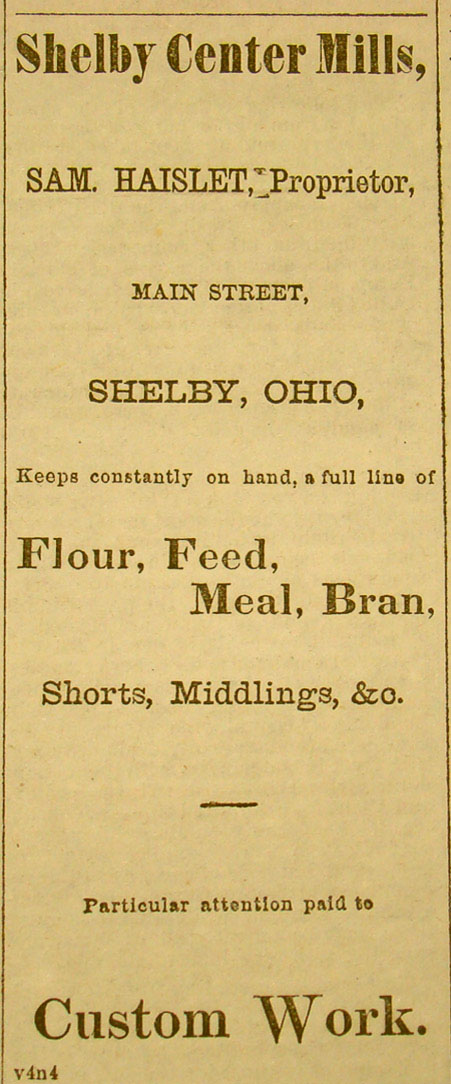
- Shelby
Independent News - December 29, 1870
-
-
- Samuel
Haislet
was born in Ohio in 1818 and married Lois Cooper (d/o Jacob and
Lydia Oakley Cooper)
- in
Richland County in 1845. They were to be the parents of 9 children:
- Hannah
Haislet born c. 1846
- George
W. born c. 1847
- William
Henry born c. 1849
- Samuel
C. born April, 1852
- Mary
born c. 1855
- James
Franklin born February, 1859
- Lois
Anna born c. 1865
- Jacob
born c. 1868
- Hattie
L. born c. 1872
-
- Samuel
was a Dry
Goods & Grocery Merchant in early Shelby. Samuel
and family were living in Shelby and he
- listed
his occupation as "merchant" and a "Dry Goods
Merchant" in both the 1860 and 1870 censuses. After
- purchasing
the Shelby Center Mills, he continued its operation for several
years, evidently with a minimum of
- maintenance,
because when the property was sold later, it was labeled "dilapidated
and run down."
-
- In
1880, having sold the Center Mills property, Samuel and family
were living in Springfield Twp,
- Samuel
gave his occupation as "grocer" and son Samuel Jr.
listed his occupation as "thresher".
- Samuel
passed away in 1890 and wife Lois died in 1902.
-
-
-

-
-
-
-
-
- Shelby
Center Mills was purchased by the Heath brothers c. 1878 and
was renamed the Shelby City Mills.
-
-
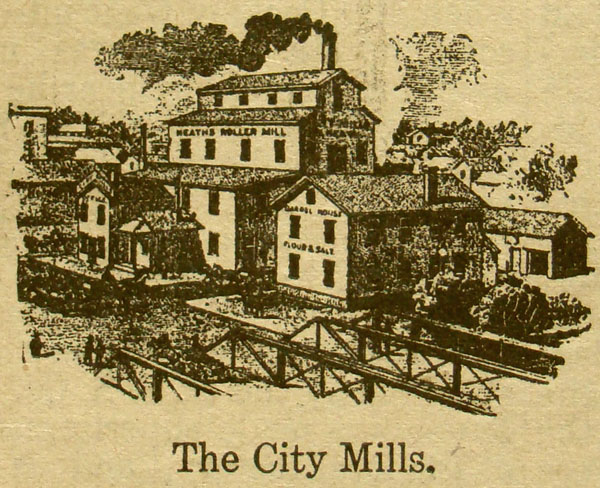
- c.
1897
-
- The
following article appeared May 20, 1897,
- in
the Shelby Republican Industrial Edition of Shelby, Ohio:
-
- "
'R. Heath, proprietor of the City Mills, was born in England
in 1840, of a family of millers, his father, grandfather, and
four uncles, as well as a brother and brother-in-law being millers.
At one time his father , grandfather, and four uncles conducted
mills on the river Avon in a radius of ten miles. At the age
of six years his father died, the business being carried on by
his mother for several years. At the age of fourteen Mr. Heath
commenced to learn the business with one of his uncles. At the
age of twenty-one, and when he had mastered his trade, he started
out as a journeyman and took charge of a mill a few days later,
after some hesitancy on the part of the proprietor giving him
so responsible a position. After two years there he started out
to complete his knowledge of the business in gaining a wide and
more varied experience, the proprietor telling him when he left,
'You are the best man for your age I ever saw.' and predicting
a certain success. He gained a position in the largest and wealthiest
milling firm in Great Britain. After ten years of daily stone
dressing, he concluded by observations made on fellow employees
that it was decidedly unhealthy and came to America in 1872,
taking service under Baker Davis, at Akron,
Ohio, the father of our esteemed townsman, M.
H. Davis,
with whom he remained three years.' "
-
- "
'After spending a year in Kent, Ohio, he came to Shelby and went
into the mill on his present location in 1877, and in 1878, associated
with his brother Henry, bought the place at sheriff's sale. The
plant was dilapidated and run down, but Mr. Heath liked the country
and the people and decided that it could be built up. He well
remembers H. W. Hildebrant telling him years ago to buy that
mill and make it look as though somebody owned it. Mr. Heath
often asks now, 'Well Hiram, old boy, have I not done it.' The
older generation of Shelby people know the answer only too well.
It is a model of neatness and repair and has a capacity of 175
barrles per day, five times that of twenty years ago. When he
came here not a barrel of flour from the mill could be found
outside of town but today it is sold at every accessible point
in Ohio, Pennsylvania, and New York and standing at the head
of the procession. His motto has always been, 'Good goods to
create a demand for them. Get them there, and keep them there
at all hazards. Never sacrifice quality for price.' Under this
motto and upon this basis of manufacture his brands have always
been winners.' "
-
- "
'His mill is most thoroughly equipped. He is quick to see new
and progressive ideas, quick to adopt them, and the plant is
recognized by experts as one of the most progressive of the day
and under the guidance of one of the best managers. Mr. Heath
is also operating an elevator at Chicago (Willard) , O., buying grain for his
Shelby mill and selling all grains, seeds, hard and soft coal,
lime and salt. He is ably assisted in the mill by a corps of
helpers and in the office by his daughters. He has always led
a purely business life and is a most fitting example of that
old adage that 'The Lord helps those who help themselves.' He
has worked faithfully and earnestly at the dusty millers' art
since fourteen years of age, a period of forty-three years, with
never an absence of over two weeks from a mill at any time. To
the young men struggling for success Mr. Heath gives this advice:
'Go in boys. Make a determined stand. Learn your business thoroughly.
Keep well posted. Be industrious. Fight every inch of the way.
Maintain your ground at all hazards. Keep your word and be reliable.
Never give up and say anything is impossible, and may you succeed
better than I have done in my art as a dusty miller.' "
-
-
-
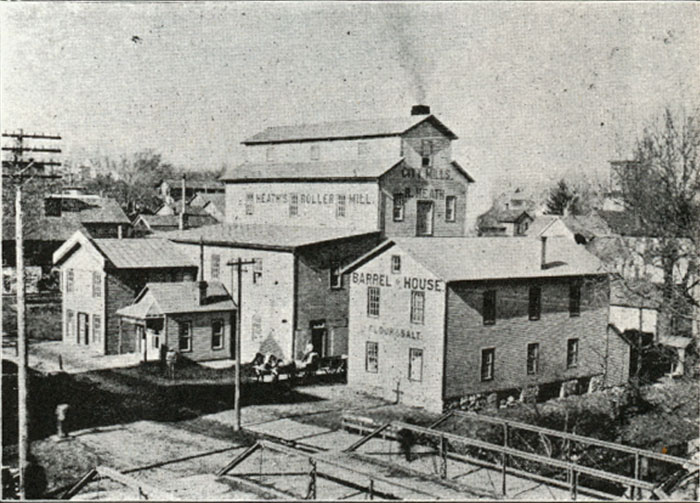
- photo
c. 1896
-
-
- The
Heath brothers, Henry and Roger, were born in Devonshire, England
in the years 1834 and 1840 respectively.
- Their
parents being Roger and Susan Cox Heath.
-
-
- Henry
Heath
married Rachel Jane Jonxson and their family consisted of:
- Susan
Heath, born April, 1859
- Lucy,
born c. 1862
- Bessie
Elizabeth born c. 1867
- William
H. born May, 1870
-
- Henry
continued working in the City Mills business many years. but
moved to Milton, Indiana shortly
- before
his death in 1898. Rachel Jane died there only a few years later
in 1902.
-
-
-
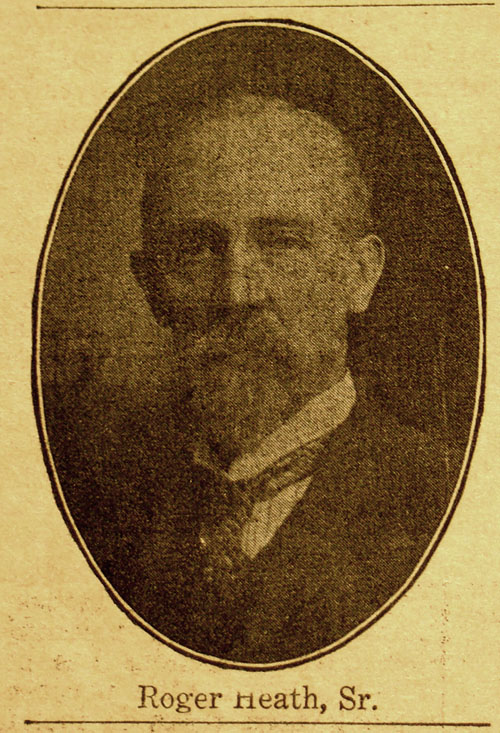
-
-
-
- Roger
Heath
married several years after Henry. He married Anna Jeanette Constance
c. 1864 and they
- immediately
began their family with the birth of Roger Heath Jr. Their children
were:
- Roger
Jr. born December 1865
- Susan
C. born c. 1869
- Fanny
F. born February, 1871
- Katherine
J. born c. 1874
- Anna
born c. 1876
- William
H. born c. 1878
- Jeanette
G. born June 1879
- Bert
Clinton born August, 1882
- Frank
L. born 1885
- George
Voere born January, 1886
- Harry
born June, 1888
-
-
-
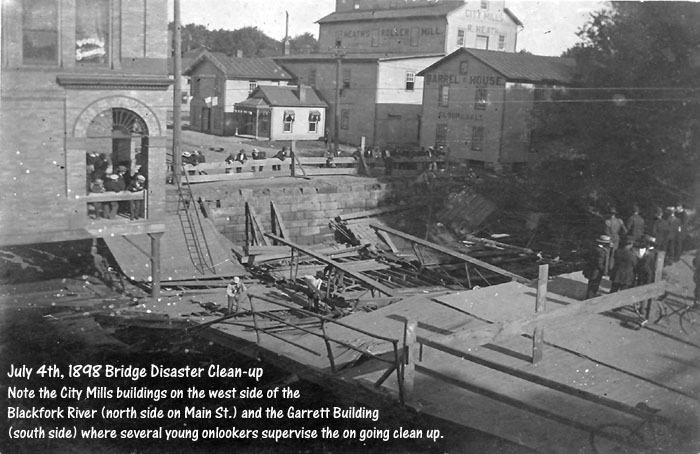
- Another
view of City Mills at the time of the Shelby Bridge Disaster
- (post
card available from the Shelby Museum collection)
-
-
-
- The
following is a portion of an article that appeared
- in
the Daily Globe - Industrial Edition - April 2, 1906:
-
- "He
(Roger)
has
more modern machinery in his establishment than in any mill of
its size in the state, and his version of the application of
new machinery and the results obtained are eagerly sought after
by mill machinery men. He has always aimed after quality rather
than quantity and has sought to create a demand for his goods,
ideas which have proved winning cards."
-
- "He
has just lately put in a valuable improvement costing $1750 and
is the second miller in the state to adopt it, the results obtained
being such as to largely add to the quality of his product. He
has made another contract calling for $750 more which will still
further increase the efficiency of the plant and serve to make
his position in the trade impregnable. This attitude of Mr. Heath
in adopting the best things regardless of cost, has placed the
old mill in the front rank in quality of goods produced. It is
never a question of quality with his customers, because his goods
are recognized as standards, but simply 'What can you sell your
product for?' "
-
- "The
mill brands of flour are Bon Ton, Imperial, Paragon, Climax,
and Moss Rose, all of which are well known and are recognized
as the highest grade of goods in their class, in the market.
Quality is the watchword and the vigilance of the proprietor
always sees to it that nothing that is not up to the standard
ever leaves the mill. During the years that Mr. Heath has been
before the public he has been uniformly successful. His business
methods have been such as to create the greatest degree of confidence,
and his word is always as good as gold. He has been connected
with the growth of Shelby for years and has materially assisited
in every endeavor to place the town in a more prosperous condition.
He was an original stockholder in the tube works, cycle works,
Shelby Foundry Co., automobile works, Land Improvement Co., Shelby
Printing Co., Citizens Bank and some minor affairs. He is president
of the Citizens Bank, president of a stock company in Cleveland
and a director of the Shelby Printing Co."
-
- "He
is a member of the board of public works, now in a second term
and has served two terms as coucilman for the east side. His
standing among his fellow men is such that any man might well
be proud of - his bluff honesty, dogged perserverance and fairness
under all conditions making him a man respected by all."
-
- "He
is assisted in the mill by his son, Will Heath, who is at present
more than an ordinary miller in capabilities and will win out.
Bert Heath, another son who is on the road to winning his way
and making trade and friends and is well liked by everyone."
-
- "The
family consists, as Roger puts it of 'the old man and wife and
ten children living with one dead, but my wife says the old man
is still the King pin of the bunch.' "
-
- Roger
was still "in charge" of City Mills in 1910 when the
census listed his occupation as: "proprietor of flour mill".
- He
passed away in July, 1911 and wife Anna J. followed him in 1934.
-
-
-

-
-
- And
finally an item appearing in the November 11, 1911 issue of the
Shelby Daily Globe:
-
- George
and Frank Heath
-
- Purchase
The Interests of Their Brothers In The Heath Mill Property.
-
- "George
and Frank Heath yesterday purchased the interest of their brothers
in the Heath Mill on Main St. Previous to the sale the property
was owned by the five brothers Will, Bert, Harry, George and
Frank. The transfer was made yesterday and the property turned
over to Frank and George. They have already assumed control of
the mill and will conduct the business in the future. Bert Heath
who has been the traveling salesman for the company will remain
with the new firm for two weeks introducing his brother Harry
to the trade and the latter will succeed him in representing
the new firm. At the expiration of this time Bert Heath expects
to locate in Colorado.
-
- The
two brothers who have taken over the property have been engaged
in the milling business all their life so that conductiong this
thriving business will not be any experiment to them. They are
thoroughly familiar with every department of the institution
and the large patronage enjoyed by this firm will be given every
care and attention. The many friends of the new proprietors wish
them every success in their business venture."
-
-

-
-
- The
1913/14 Shelby directory shows that Bert and George were living
at the family home at 25 Second Street and were still
- employed
at the City Mills. Frank Heath and wife Jennie were living at
38 East Main Street.
- .
-

-
-
- The
November 24, 1914 issue of the Daily Globe has a large article
concerning the Heath Flour and Grist Mill.
- A
portion of the article states as follows:
-
- "Bert
Heath, the present owner and proprietor of the mill, was employed
in the capacity of traveling salesman of the mill for twelve
years, and at the death of his father fell heir with the remainder
of his brothers to the business. For five years prior to his
going on the road Bert was employed in the mill, assisting his
father with the duties of the institution. Robert George succeeded
Mr. Heath three years ago, and at the present time he is still
employed in that capacity."
-
-
-



















